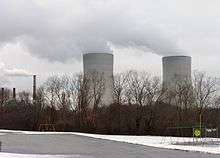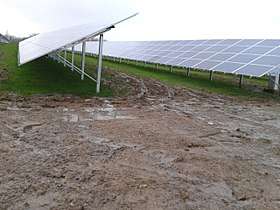Brayton Point Power Station
Brayton Point Power Station was a coal-fired power plant located in Somerset, Massachusetts. It was the largest coal-fired generating station in New England, and was the last coal-fired power station in Massachusetts to provide power to the regional grid.[1] It had been owned by the power company Dominion Energy New England since 2005,[2] after it was purchased from PG&E. The plant was owned from August 2013 to April 2015 by Energy Capital Partners,[3] and is now owned by Dynegy. The plant ceased power generation and went offline on June 1, 2017.[4]
| Brayton Point Power Station | |
|---|---|
Brayton Point Power Station | |

| |
| Country | United States |
| Location | Somerset, Massachusetts (near Fall River, Massachusetts) |
| Coordinates | 41°42′45″N 71°11′38″W |
| Status | Offline |
| Construction began | 1957 |
| Commission date | 1963 |
| Decommission date | 2017 |
| Owner(s) | Dynegy |
| Thermal power station | |
| Primary fuel | Coal |
| Secondary fuel | Oil (Primary Fuel 1969–1981) |
| Cooling source | Taunton River (1963–2011) Cooling Towers (2011-2017) |
| Combined cycle? | Yes |
| Power generation | |
| Units decommissioned | 4
Unit 1: 243 MW 3 Diesel Generators (7.6 MW Combined) |
| Nameplate capacity | 1,537.6 MW |
| External links | |
| Commons | Related media on Commons |
Operations
The power station began operations in the 1960s and was one of the largest in New England, standing on a 306-acre site.[5] The plant had 262 full-time staff, with four power generating units powering in the region of 1.5 million homes using coal, natural gas and oil as its fuel sources. Its energy outputs from the four units were:
- Unit 1: 243 megawatts[5]
- Unit 2: 240 megawatts
- Unit 3: 612 megawatts
- Unit 4: 435 megawatts
Brayton Power Station had been estimated to burn 40,000 tons of coal in three days, and fresh supplies were brought by barge every four days. The coal was brought from Colombia, Kentucky, and Colorado.[5]
Environmental improvements

With regulations and concerns from the public, Dominion agreed to make investments to improve in the environmental impacts of the plant in two areas.
The first area was to decrease emissions of mercury, sulfur oxide and nitrogen oxide through the implementation of a system called Novel Integrated Desulphurization (NID). The NID injects lime to allow its reaction with the fumes to separate chemicals from the smoke which reduces the emissions of mercury and sulfur oxide. The company also implemented another system to pass the fumes through ammonia to reduce nitrogen oxide emission. The company reported having reduction of those emissions by 90 percents after the installation.
The other area was to reduce the impact on the water consumption and the release of heated water which was killing fish. Dominion began construction of two 500-foot cooling towers in 2009, which were completed in 2011 at a cost of $600 million. This was to create a closed-cycle water cooling system whereby the heated water is cooled by the towers and the water is recycled back to be used in the system again. This stopped the heated water being released back to Mount Hope Bay.[6]
Sale and shutdown
In March 2013, the Virginia-based owners Dominion announced that Equipower would purchase the power station.[5] The purchase was closed in August 2013 as part of the $650 million deal that Energy Capital Partners took over three power plants, including two other plants in Illinois, the natural gas-fired Elwood Power Station and the coal-fired Kincaid Power Station.[7] In September 2013, the new owners announced that the plant would be shut down in May 2017, citing low electricity prices as well as high costs to meet environmental standards and maintain aging facilities.[8][7] It was the last coal-fired power station in Massachusetts.[1][9][10]
Brayton Point Power Station, a timeline
- 1957
- New England Power purchased the land for Brayton Point Power Plant
- August 1, 1963
- Brayton Point Power Plant service begins
- July 1964
- Unit 2 goes on line
- 1969
- Third generating unit constructed with the capacity to burn coal or oil
- July 29, 1969
- Third unit went online making the station's total generating capacity 1,100,000 KW
- End of 1969
- All three units, originally designed to burn coal, were converted to burning oil as a result of low oil prices at the time
- May 1973
- The Department of the Army Division Corps of Engineers issues draft environmental statement on addition of a 4th generating unit at Brayton Point. Environmental groups contest the expansion because of water resources Brayton Point is using from Mount Hope Bay and the heat being discharged from the existing three units. A resident says the plant's continued abuse of the air, land, and water, combined with size, presents a daily threat to the quality of life in the area.
- March 30, 1981
- Permanent coal burning began as Unit 1 begins burning coal on a permanent basis
- August 17, 1988
- Brayton Point celebrates 25th anniversary of commercial operation in Unit 1
- June 26, 1995
- Rhode Island Department of Environmental Management study blames Brayton Point for unique loss of aquatic life in Mount Hope Bay of 87 percent.
- October 23, 1996
- EPA revokes Brayton Point water discharge permit two years before it was set to expire, concerned about decline in Mount Hope Bay fish populations
- September 16, 2000
- Brayton Point must stop use of unlined basins to filter ash-- ash contains metals that can find their way into groundwater
- June 6, 2001
- Mount Hope Bay's temperature has risen two degrees, a warming trend based on discharge from Brayton Point Power Plant in Somerset, according to a study released by a Brown University geologist.
- October 3, 2001
- Brayton Point is investing in ambitious new technology to reduce emissions, increase recycling of coal ash and limit any potential damage to Mount Hope Bay... The plant's parent company, PG&E Corp., plans to spend $250 million on these projects
- June 8, 2002
- Brayton Point Emission Plan approved to comply with acting Gov. Jane Swift's tougher regulations on power plants
- July 25, 2002
- On Monday, EPA released its draft water discharge permit for the plant, which stated the station must dramatically reduce the amount of water it withdraws from and discharges back into Mount Hope Bay... The massive cuts will force the power plant to install a closed-cycle cooling system to reduce the amount of hot water discharge.
- October 7, 2003
- EPA approved a new permit that will force the plant to virtually stop releasing massive amounts of heated water into the Taunton River daily, a situation that environmentalists say decimated the fish population.
- September 10, 2004
- USGen New England Inc. agrees to sell Brayton Point and two other power plants to Dominion Resources Inc. of Richmond, Virginia for $656 million
- June 13, 2005
- Inflating of a 107-foot tall dome erected by Dominion Energy New England in Somerset in an effort to reduce fly ash produced at the plant
- July 27, 2005
- Environmental groups' report showed that coal-fired Brayton Point Power Station at that time was the top carbon dioxide emitter in the Northeast.
- 2006
- Brayton Point installed pulse jet fabric filters (PJFFs) on Units 1 and 2 in series with the existing Koppers and Research-Cottrell electrostatic precipitators (ESPs)to reduce fine particulate, especially PM 2.5 (particulate with particle diameters of 2.5 microns or less). It also installed a "common" spray dryer absorber (SDA)to reduce sulfur dioxide (SO2) emissions. The SDA was common to, and treated the flue gas from, both Units 1 and 2. A limestone preparation plant and a powdered lime and water slurry injection system, spraying downwards at the top of the SDA, was installed to react with the sulfur dioxide to form calcium sulfate. A powder activated carbon (PAC) storage and injection system was also installed on both Units 1 and 2 to reduce mercury emissions. The PAC was injected upstream of the ESPs. The fly ash was pneumatically conveyed to storage silos. Two "booster" centrifugal fans were installed on each Unit to provide additional induced draft to overcome the pressure drop across the PJFFs. The equipment was supplied by Wheelabrator Air Pollution Control, Inc. (changed to Siemens during the construction) and the general construction contractor was Nicholson & Hall Corp. based in Buffalo, NY. Construction was performed in 2006 and 2007.
- October 25, 2007
- Dominion reaches agreement with Cambridge-based startup GreatPoint Energy to build a demonstration facility and research and development center for its new natural gas conversion process
- January 23, 2008
- Dominion reps show renderings and details of proposed 500-foot cooling towers to Somerset residents that they were required to build as a result of agreement with federal EPA
- February 23, 2008
- On Tuesday, EPA New England Regional Office released list of top five polluters in MA for 2006 and Brayton Point topped the list.
- September 1, 2009
- Construction is under way on Dominion Energy's two massive 500-foot cooling towers aimed at eliminated the environmental impact of heated water being pushed back into Mount Hope Bay.
- October 2011
- The first 497-foot-high cooling tower at Brayton Point power plant will begin use for the first time, a major step in the $620 million project.
- March 12, 2013
- Dominion announced Monday that the coal-powered Brayton Point Station has been sold to Energy Capital Partners
- July 29, 2013
- About 44 protesters were arrested for trespassing onto the Brayton Point Power Station site as they marched, while holding handmade signs, and chanted with more than 300 others late Sunday morning in the shadow of the plant's two cooling towers. Protesters chanted, sang and cheered on speakers who urged state leaders to shut down the coal-fired plant they described as an environmental menace.
- September 2, 2013
- Energy Capital Partners, an energy infrastructure company headquartered in Short Hills, N.J., bought Brayton Point and two Illinois power plants for $650 million, including tax credits, on September 2.
- October 8, 2013
- Unable to reach a new deal to supply power to ISO New England, the region's electric grid utility, the new owners of Brayton Point Power Station announced Monday that they plan to close the 1500-megawatt coal-fired plant by June 2017.
- January 4, 2014
- Owners of Brayton Point Power Station and ISO New England could return to price negotiations after the administrators of the region's wholesale electricity market recently said the 1535-megawatt resource "is needed to ensure reliability" for at least another year.
- January 28, 2014
- The owners of the Brayton Point power plant announced Monday that they will go ahead with plans to close the facility in 2017, despite the request of regulators that they keep the plant open.
- August 23, 2014
- Dynegy Inc. announced that Brayton Point is part of a $6.25 billion package of power plants – totaling 12,500 megawatts of coal, gas and oil generation – it was acquiring in two separate deals. Dynegy spokeswoman Katy Sullivan said the Houston, Texas-based company planned to honor the agreement made by Energy Capital Partners, Brayton Point's current owner, which pledged to retire the 1535-megawatt coal plant on May 31, 2017, and to complete its decommissioning.
- February 19, 2017
- Several workers leaving their shifts Friday afternoon confirmed they believed this was the final coal shipment.
- May 31, 2017
- Brayton Point Power Station closed.
- September 25, 2018
- Commercial Development Company received permits to demolish the pollution emission stacks and the cooling towers
- March 24, 2019
- Three generating units demolished. Controlled Demolition, Inc. of Phoenix, Maryland performed the preparation for and successful explosives felling of three 350 foot tall reinforced concrete chimneys on Sunday, March 24, 2019 at 8 am local time.
- April 27, 2019
- The two 500-foot tall cooling towers previously used to reduce thermal pollution due to the production of superheated water inside the plant were demolished on Saturday, April 27, 2019 at 8 am local time. There was a lottery system to enter in which the winner got to press the button to implode the towers. Controlled Demolition, Inc. of Phoenix, Maryland performed the preparation for and successful explosives felling of the two cooling towers.
- February 22, 2020
- The Final Chimney is imploded at 9 am local time.
The Future of Brayton Point
- There are extensive plans to balance the negative economic effect that the closure of Brayton Point Station may produce.
Clean Energy Options
- Clean energy investments tend to stay within the local community. New installations often involve local contractors, who re-spend wages within the region. A switch to clean energy resources can have the effect of recapturing the dollars that, under fossil fuel-based operations, left the state in the form of payments for fuel and equipment. As the Somerset community works with the state and the Brayton Point property owners to determine the best option for reusing the site, they will be carefully considering the future they wish to see for this 234-acre waterfront property. Alternative options such as the Clean Energy Hub scenario show a vision of the future that would allow for the restoration of some of the town’s tax revenues, provide clean, reliable electricity for the region, provide jobs and help advance technological innovation, and reduce pollution and other industrial burdens on the town’s waterfront and surrounding communities.
- Solar

- Utility-scale solar is a renewable energy option for the Brayton Point site. The Clean Energy Center estimated that up to 9 MW capacity of solar panels could be installed at the Brayton Point site under the “Mixed Energy Hub” scenario. To illustrate the differences in scale: a single 9 MW utility-scale project has the same capacity as 1,800 residential rooftop installations at 5 kW each. Solar PV is not expensive to operate and has no fuel costs. And, helpfully, solar power often operates at times when the electric grid needs it most—on hot, sunny days when air conditioning usage increases and energy requirements from the grid are at or near their peak.[11]
- Off-shore Wind Farm Staging Hub

- The Brayton Point site could become a critical component of offshore wind development in the United States. A 2014 study commissioned by the Clean Energy Center identified Brayton Point as one of the best interconnection points for offshore wind energy in the region.[12] The site was originally developed with two purposes: to support the power produced by the Brayton Point facility and also to act as a regional power hub. The existing high voltage transmission infrastructure at Brayton Point provides a strong backbone for interconnection to surrounding lower voltage systems and could accommodate up to 2,000 MW of offshore wind at an estimated cost of $20 million with minimal investment in new landbased transmission facilities. Depending on the size of interconnection required, necessary new facilities would consist of one or two new buildings, occupying at most 5-10 acres of land on the Brayton Point site. This would leave ample room for additional job- or tax-creating activities.
Energy Legislation to assist with 'renewable resources' at Brayton Point
- 1997 Restructuring Act - Opened the electricity market to competition and innovation, setting the stage to over 109,000 clean energy jobs in the state today."1997 Restructuring Act". Act No. 164 of 1 July 1997.
- 2008 Green Communities Act - Created the Green Communities Program, aimed at providing financial assistance for efficiency and conservation projects at the municipal level. To qualify, a municipality must agree to a streamlined permitting process for new renewable projects and meet other benchmarks."2008 Green Communities Act". Act No. 169 of 1 July 2008.
- 2016 Energy Diversity Act - Signed into law on August 8, 2016. Sets procurements for 1600 megawatts of offshore wind. These represent the largest purchase of clean energy in the Commonwealth's history."2016 Energy Diversity Act". Act No. 188 of 1 July 2016.
- Implementation of the 2016 Energy Diversity Act - On August 2, 2018, the electric utility companies signed contracts for an 800-megawatt offshore wind farm to be built by Vineyard Wind at a levelized price of 6.5 cents a kilowatt hour for 20 years. The offshore wind farm will result in 3,600 jobs in the region during the construction phase and has a 2021 in-service date."2016 Energy Diversity Act". Act No. 188 of 1 July 2016.
References
- "Massachusetts State Energy Profile". eia.gov. U.S. Energy Information Administration. Retrieved 3 February 2017.
- Edes, Alyssa. "Dominion sells Brayton Point power station". bostonglobe.com. Retrieved 5 May 2013.
- Holtzman, Michael (2 September 2013). "Energy Capital Partners buys Brayton Point from Dominion". Herald News. Retrieved 16 December 2013.
- Finucane, Martin (2017-06-01). "Mass. says goodbye to coal power generation". Boston Globe.
- "Brayton Point Power Station". www.dom.com. Archived from the original on 5 February 2013. Retrieved 5 May 2013.
- Wittenberg, Ariel (11 August 2013). "An inside look at Brayton Point Power Plant in Somerset". South Coast Today. Retrieved 16 December 2013.
- Kuffner, Alex (8 October 2013). "New owners to shutter outmoded Brayton Point Power Station in 2017". Providence Journal. Retrieved 16 December 2013.
- "Brayton Point Power Station Closing: Massachusetts Coal-Fired Plant Shutting Down In 2017". Huffington Post. 8 October 2013. Retrieved 8 October 2013.
- Feature on Brayton Point Power Station closing, WGBH-HD television, June 13, 2017
- Serreze, M.C. Last coal plant in Massachusetts to close for good June 1. Updated on May 24, 2017 at 4:31 PM. MassLive.com
- Jackson, Sarah. "Clean Energy Options for Brayton Point". Synapse Energy Economkics Inc. Retrieved March 4, 2016.
- "BOEM Atlantic Coast Offshore Wind Ports Study". ESS Group. Energy Initiative Group, Power Systems Consultants. Retrieved 2014. Check date values in:
|accessdate=(help)
- Raymond, Kenneth (November 20, 2018). "An interview with Kenneth Raymond" (Interview). Interviewed by Jonathan Furtado. Somerset, MA.
- Haddad, Patricia (October 19, 2018). "An interview with Massachusetts State Representative Patricia Haddad" (Interview). Interviewed by Jonathan Furtado. Somerset, MA.